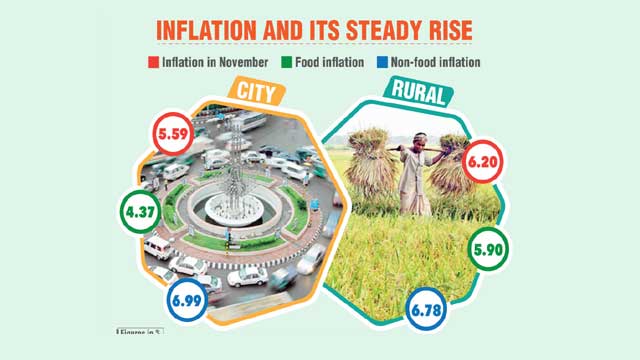According to data analysis, and discussions with economists and market participants, the Covid-19 shock has caused inflation in rural areas to increase at a much higher rate.
The prices of almost all daily necessities are higher in rural areas than in cities, and the price of food products has increased the most.
Although some analysts have blamed rising fuel prices, the data shows that the graph of inflation has been on the rise for the last five months of the current fiscal year, whereas the price of fuel was adjusted on the third of last month.
The country's overall inflation, which has been steadily increasing in the current fiscal year, has risen to 5.98%. It was 5.70% in October.
According to the latest published data from the Bangladesh Bureau of Statistics (BBS), rural areas logged 6.20% inflation in November, up from October's 5.81%.
November’s food and non-food inflation breakdown in rural areas is 5.90% and 6.78%, respectively.
On the other hand, urban inflation rose to 5.59% from 5.50% in October -- food and non-food inflation rates were 4.37% and 6.99%, respectively.
Zahid Hossain, a former lead economist at the World Bank's Dhaka office, said: “As diesel prices have risen, so have transportation costs. Rising transport costs have had an impact on the commodity market. I think that's one of the main reasons behind the November inflation rate.
“Another reason for rising prices in rural areas is a lack of market monitoring,” he added.
The inflation rate in June (the last month of the previous financial year) was 5.64% which decreased to 5.36% in the following month. But since then, inflation has been rising steadily.
In August, September, October and November the rates were 5.54%, 5.59%, 5.70% and 5.98% respectively.
Upon asking about the steady rise of inflation, AB Mirza Azizul Islam, economist and former financial adviser to the caretaker government told Dhaka Tribune: “The demand for both food and non-food items in the market are increasing after the Covid-19 shock. Fuel and edible oil prices have risen and prices of some products and raw materials have also gone up in the international market. Meanwhile, the value of the Taka has declined against the Dollar as well. I think all these factors have been continuously affecting the inflation rate of the country for the last few months.”
He added: “The people of rural areas are facing the biggest problem of inflation due to various reasons including lack of accountability and the distance of transporting goods.”
The government set the inflation target at 5.30% in the budget for FY 2021-22.





